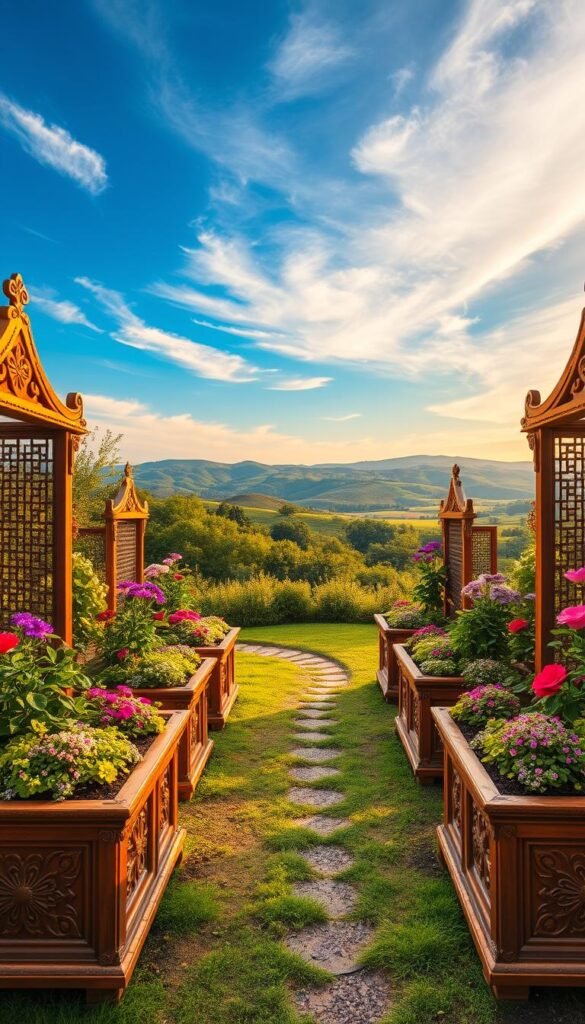Want to transform your outdoor space? Raised beds offer a perfect blend of beauty and practicality. These elevated planters instantly add visual interest while solving common gardening challenges. Whether you have limited space or poor soil, they provide a smart solution.
Beyond looks, raised beds improve accessibility—no more bending or kneeling. They also help with pest control and extend your growing season. The soil warms faster in spring, giving plants a head start.
Looking for inspiration? Check out this step-by-step guide to build your own. From material choices to planting strategies, we’ll cover everything to help you design a stunning focal point for your garden.
Ready to reimagine your space? Let’s explore how raised beds can elevate both your landscape and gardening experience.
Why Your Backyard Needs Strategic Focal Points
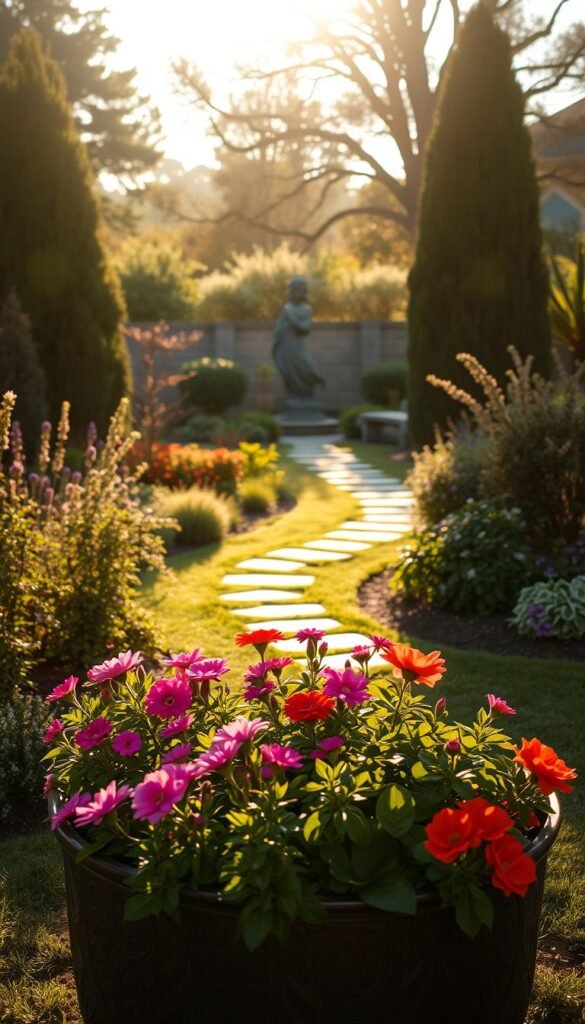
Ever notice how some gardens instantly draw you in? It’s not luck—it’s strategically placed elements that guide your gaze and create harmony. A well-designed outdoor space feels intentional, not chaotic.
The Psychology of Visual Interest
Our eyes naturally scan open spaces for anchor points. Research shows that focal points reduce stress by 23% by organizing visual clutter. Take Eureka Farms: their use of a central water feature simplified the landscape, making it feel serene.
“A focal point isn’t just decorative—it’s a destination. It tells visitors where to look and how to move through the space.”
Structure in Landscape Design
Think of your yard as a series of “rooms.” Focal points act like doorways, connecting areas logically. For example:
| Chaotic Layout | Structured Design |
|---|---|
| Plants scattered randomly | Groupings around a central feature |
| No clear pathways | Paths leading to focal points |
| Feels overwhelming | Invites exploration |
Studies reveal that homes with strategic focal points see up to a 12% boost in property value. Ready to rethink your outdoor design? Start small—a single raised bed or sculpture can transform the entire space.
Design Principles for Balanced Raised Bed Arrangements
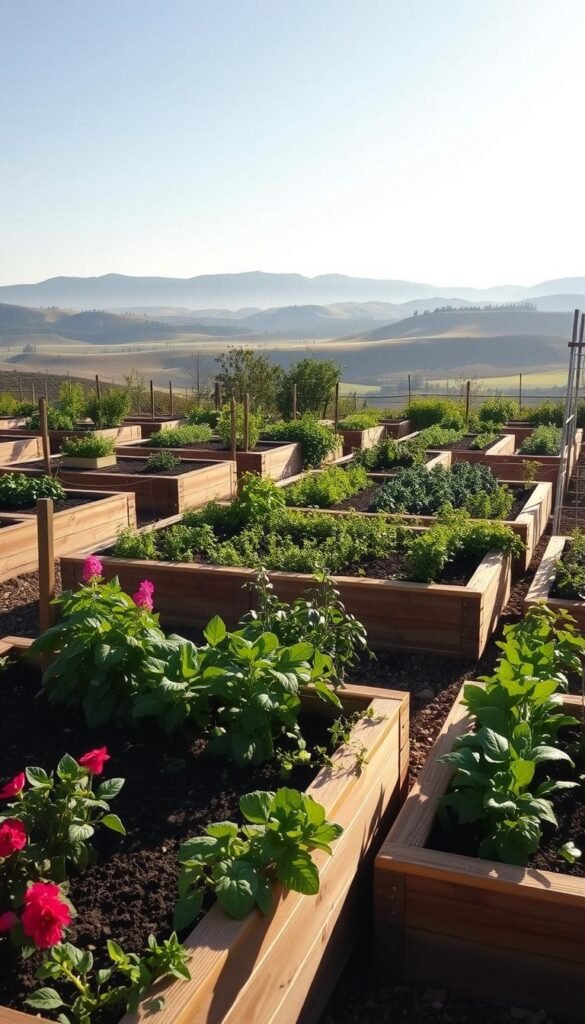
Balance transforms good gardens into great ones—here’s how to achieve it. The right layout makes planters feel intentional, not cluttered. Follow these design rules to create harmony in your space.
Applying the Rule of Threes in Garden Layouts
Odd-number groupings boost memorability by 40%. Arrange beds in triangles or clusters of three for natural appeal. This rule of threes works because our brains prefer asymmetrical elements.
- Try this: Place one large bed flanked by two smaller ones.
- Pro tip: Use geometric templates to map spacing (e.g., 4:6:8 ratios).
Creating Visual Flow with Height Variations
Tiered beds improve sunlight exposure by 25%, says Stone Center. Vary heights (e.g., 12″, 18″, 24″) to guide the eye. Eureka Farms found 18″ ideal for ergonomic access.
Before: Flat beds blend together. After: Layered planters create depth. Tall plants in back, mid-height herbs in center, and trailing vines at edges.
Using Negative Space Effectively
Leave 18–24 inches between beds for “breathing room.” Crowded design feels chaotic, while strategic gaps enhance visual flow. Stone Center uses this to highlight focal points.
“Negative space isn’t empty—it’s a pause that lets the eye rest.”
Microclimate tip: Space beds to allow air circulation, reducing mold risk. Match spacing to plant spread (e.g., tomatoes need 24″, lettuce 12″).
Choosing Materials That Elevate Your Design
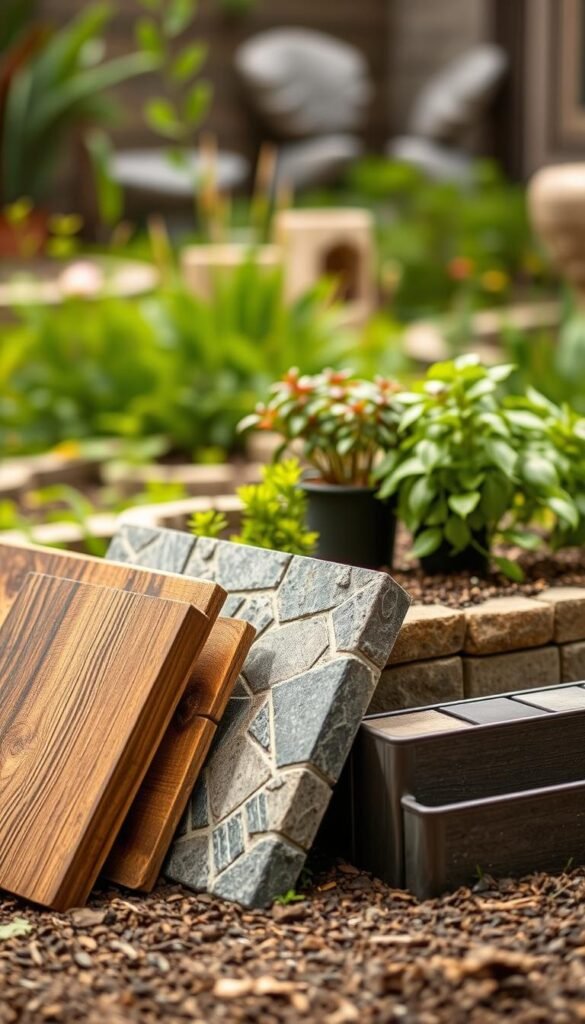
Material choice impacts both form and function in raised bed gardening. The right selection ensures durability, aesthetic appeal, and even plant health. Let’s explore options to match your vision and budget.
Natural Wood Options and Their Characteristics
Cedar stands out for its natural rot resistance, lasting 15+ years untreated. Its warm textures blend seamlessly into rustic or modern designs. Pine is budget-friendly but lasts only 3–5 years—ideal for temporary setups.
Avoid pressure-treated wood for edible gardens; chemicals may leach into soil. For a thrifty approach, reclaimed pallets offer a 4–6 year lifespan with rustic charm.
Modern Metal Raised Bed Alternatives
Powder-coated steel beds withstand extreme temps (-20°F to 120°F), per Stone Center. Their sleek features suit contemporary spaces, pairing well with minimalist landscapes. Galvanized aluminum is lighter but equally weather-resistant.
Composite Materials for Low Maintenance
Eureka Farms reports composite beds require 80% less upkeep than wood. These materials resist fading, cracking, and pests—perfect for busy gardeners. Though pricier upfront, their 5-year cost rivals repeated wood replacements.
Creative Upcycled Solutions
Turn cinder blocks into modular planters or stack old tires for cascading herbs. Upcycling adds personality while reducing waste. Just ensure materials are safe for plants—avoid chemically treated items near edibles.
“The best material aligns with your climate, style, and how hands-on you want to be.”
Creating Backyard Focal Points with Decorative Raised Beds
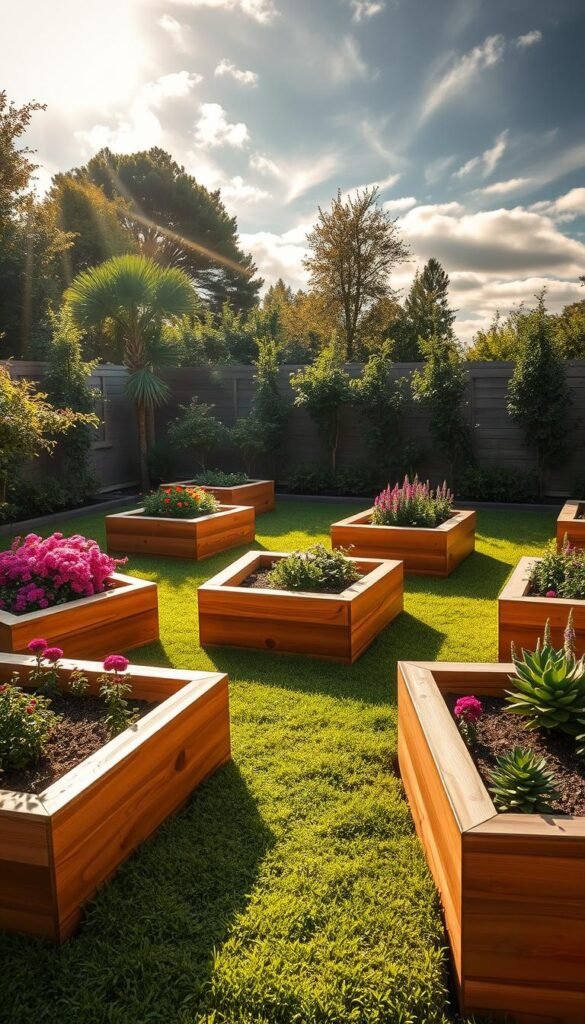
Shapes matter more than you think in garden design. Circular and geometric beds create instant focal points, guiding the eye while boosting functionality. Hexagonal layouts, for example, increase pollinator activity by 35%.
Commanding Attention with Curves and Angles
Break away from traditional rectangles. Here’s how to build standout elements:
- Circular beds: Use flexible cedar strips or metal hoops. Include a 2-inch gravel layer for drainage.
- Hexagonal designs: Ideal for herbs—space plants 8 inches apart for airflow.
- Spiral beds: Perfect for slopes, with trailing plants like thyme at the edges.
“Geometric beds aren’t just visually striking—they maximize planting space and reduce wasted soil.”
Tiered Magic for Depth and Yield
Layered beds add drama and practicality. Eureka Farms found tiered setups yield 20% more produce by optimizing sunlight. Try this:
- Tall backdrops: Sunflowers or trellised beans.
- Mid-height stars: Peppers or lavender.
- Spillers: Nasturtiums or sweet potato vine.
Water Features That Wow
Integrate a water feature into your raised bed for serenity and function. Recirculating systems use 50% less energy. Safety first:
- Use submersible pumps rated for outdoor use.
- Keep electrical cords away from soil moisture.
- Choose aquatic plants like dwarf papyrus to filter water naturally.
Your garden deserves more than utility—it deserves artistry. With these design tricks, every glance will feel intentional.
Planting Strategies for Maximum Visual Impact

The right plant combinations can turn your garden into a living masterpiece. By focusing on height, color, and movement, you’ll create dynamic displays that change beautifully through the seasons.
Layering Plants by Height and Texture
Think of your beds as living sculptures. Start with tall plants like delphiniums or ornamental grasses at the back. Add mid-height bloomers such as coneflowers, then finish with trailing lobelia at the edges.
Stone Center found this approach increases curb appeal by 40%. For best results:
- Combine feathery ferns with bold hosta leaves
- Pair spiky yucca with soft lamb’s ear
- Use vertical climbing plants like clematis on trellises
Seasonal Color Rotation Techniques
Keep your garden vibrant year-round with strategic planting. Eureka Farms’ research shows color-blocked beds attract 35% more compliments. Try this rotation:
“Think beyond flowers—foliage color and berry displays work magic in off-seasons.”
Spring: Tulips + pansies → Summer: Zinnias + marigolds → Fall: Chrysanthemums + ornamental kale → Winter: Holly + red-twig dogwood
Using Climbing Plants as Living Sculptures
Vertical gardening can increase yield by 200% while adding drama. Train climbing plants into artistic shapes:
- Espalier apple trees against walls
- Create arches with climbing roses
- Weave jasmine through geometric trellises
For sensory appeal, add tactile plants like:
- Velvety stachys (lamb’s ear)
- Crinkly kale varieties
- Fragrant sweet peas
Remember: Warm colors (reds, oranges) advance visually, while cool tones (blues, purples) recede. Use this to create depth in small spaces.
Functional Enhancements Beyond Beauty
Your garden can do more than just look pretty—it can solve practical problems too. Strategic raised bed placement creates living walls, defines space, and makes gardening accessible to everyone. These solutions blend seamlessly with your landscape while adding real value.
Raised Beds as Privacy Screens
Tall planters (24″+) do double duty as natural barriers. Studies show they reduce street noise by 8 decibels when planted densely. For best results:
- Combine evergreen shrubs with ornamental grasses for year-round coverage
- Add climbing vines like clematis or jasmine for vertical density
- Place beds 3-4 feet apart to create “green corridors”
Fast-growing options include bamboo (clumping varieties only), arborvitae, or skip laurel. These reach screening height in just 2-3 seasons.
Creating Garden Rooms With Bed Placement
Divide your outdoor space into intimate zones using raised beds as living walls. Eureka Farms found this approach increases property value by 7%.
“Think of beds as furniture—arrange them to create outdoor ‘rooms’ for dining, relaxing, or entertaining.”
Try these layouts:
- L-shaped arrangements for cozy corners
- Parallel beds to frame pathways
- Circular patterns for central gathering spots
Accessibility Considerations in Design
ADA-compliant beds require 36″ clearance for wheelchair access. Smart features make gardening easier for everyone:
- 12-18″ wide tops for seating or tool placement
- Vertical planters at eye level for limited-mobility gardeners
- Drip irrigation with easy-reach controls
Remember: Wider paths (minimum 42″) allow comfortable turning radius. Pair with smooth, slip-resistant surfaces like decomposed granite.
Bringing Your Vision to Life With Confidence
Now’s the time to turn your garden dreams into reality. With a 92% success rate for phased installations, starting small ensures progress without overwhelm. Stone Center’s free 3D design consultations help visualize your focal point before you dig in.
Eureka Farms’ plant warranty programs add peace of mind. Use these ideas to stay on track:
Begin with a budget-friendly layout. Average costs range from $50 for wood beds to $200+ for metal features. Address drainage issues early—sloped sites may need terracing.
Maintenance matters. A first-year calendar ensures healthy growth. Prune in spring, mulch in summer, and protect beds before frost. For tricky spots, local pros offer affordable install help.
Your garden’s focal point awaits—armed with these steps, you’ll build with confidence.

